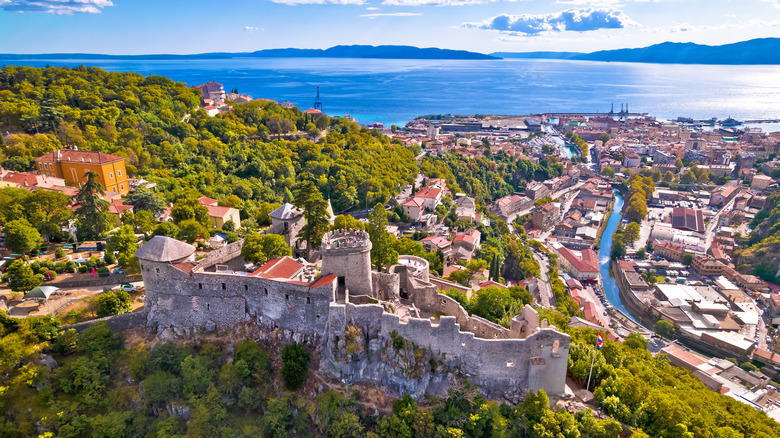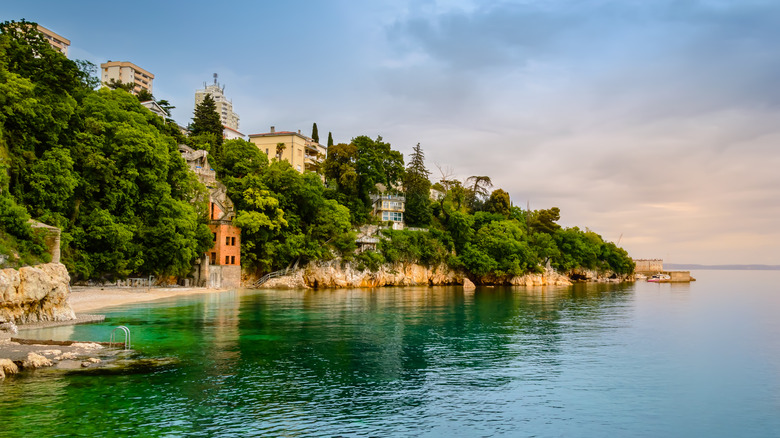One Of The World's Best Digital Nomad Destinations Is The Gorgeous 'Gateway To Croatia's Islands'
If you head northwest along Croatia's Adriatic shoreline, with the sea to your left and the vibrant coastal towns to your right, you'll reach the port city of Rijeka. Croatia's third-largest city, with a population of over 106,000, Rijeka is nestled in a postcard-worthy mountain valley under the shadow of the Julian Alps. Its name, which dates back to the 13th century, is different in Slovenian, Italian, Serbian, and other languages — but it always translates to "river," an apt name for a city bifurcated by the Rječina. This tranquil river winds its way through a picturesque canyon before emptying into the Adriatic.
Rijeka is also known as the "Gateway to Croatia's islands." It earned this moniker for its strategic location right along the coast. Indeed, this bustling port city is your link to some of the most beautiful islands in the northern Adriatic Sea, including Cres, which has some of the best beaches in all of Croatia, Krk, and Lošinj, Croatia's underrated "Island of Vitality." But although it's considered a gateway, this doesn't mean that the city isn't worth a visit of its own. Due to its long history of occupation and settlement — it's been under French, Hungarian, Austrian, and Croatian rule at various points — the city is a unique confluence of cultures. This is visible in its architecture in particular, where you'll see Modernist towers and Art Nouveau façades alongside opulent Habsburg-era buildings and medieval fortresses. Besides its interesting architecture and ancient ruins, Rijeka offers a gorgeous coastline, a multitude of cultural activities, excellent restaurants and cafés, and outdoor adventures galore. And in more recent years, Rijeka has become a hotspot for digital nomads, attracting remote workers aplenty with its excellent connectivity, mild climate, affordability, and spectacular Mediterranean beauty.
Rijeka's appeal for remote workers
Despite its seemingly obvious appeal, Rijeka is often overshadowed by more famous tourist hubs, like the sun-soaked Dalmatian city of Split and Dubrovnik, where you can visit key "Game of Thrones" filming locations. In fact, it gets around 220,000 visitors a year, compared to a million for Split and 1.4 million for Dubrovnik (not even including cruise passengers). But this city hasn't been overlooked by digital nomads searching for the perfect locale to set up shop temporarily. Rijeka was ranked 15th on a list of the top 100 digital nomad destinations in 2025 by HotelWithTub, lauded for its safety and calm pace of life. And on Nomads.com, members gave the city high scores in the areas of internet connectivity, friendliness of locals, and walkability.
Rijeka seems almost perfectly set up for the remote-worker lifestyle. While there's a robust public transportation network, most places can be reached on foot within 30 minutes. There are a number of coworking spaces sprinkled throughout the city, with RiHub being particularly popular. Garnering an average 4.8 rating on Google Reviews, RiHub is an excellent spot to meet like-minded nomads — and it was set up by the city, so it's free to use. Additionally, there are several accommodations targeted specifically to remote workers, along with dedicated Facebook pages like Digital Nomads Croatia Housing. In general, Rijeka has a low cost of living, especially in comparison to other European cities. Nomadlyf puts the total monthly cost at between $1,800 and $2,500, while HotelWithTub places it at around $1,846. A recent change to Croatian law has also sweetened the deal for digital nomads: As of March 2025, non-Croatian nationals can apply for an 18-month temporary residence permit (previously, it was only 12 months).
Getting to, from, and around Rijeka
To reach Rijeka by plane, you'll fly into Rijeka International Airport, about 30 minutes by car from the city center. Other possible options include Pula Airport (PUY) in Pula, Croatia (65 miles away) and Franjo Tuđman Airport (ZAG) in Zagreb, Croatia (110 miles away). There are no direct flights from the U.S. to any of these airports, although there's a non-stop option available from Toronto to Zagreb. If you're already in Europe and keen to travel by land, hop on one of the intercity buses (FlixBus or Arriva) or use Europe's extensive and convenient rail network. You can even reach Rijeka from Warsaw on a scenic 20-hour journey — as of June 2025, this European sleeper train now links Poland to the Adriatic Sea.
A plethora of intracity bus lines serve Rijeka, and fares are reasonable (around $2 for a single fare and $15 for a Zone 1 weekly pass). Ride-share services, like Uber and Bolt are available too, while BlaBlaCar can be used for longer distances. If you're feeling more adventurous, you can find rentable electric scooters, e-bicycles, and mountain bikes at various stations. And, of course, it's possible to walk to most places — but keep in mind that some areas of this hillside city are heavy on stairs and slopes.
To visit the breathtaking Mediterranean isles for which Croatia is known, regular catamaran and ferry lines, including Jadrolinija, operate daily routes from Rijeka's port. Spend some time exploring Kvarner Bay islands at your leisure. Wander through Rab's historic town and ancient streets, or search for secluded coves on Cres. Experience the unique culture and dialect of Susak, or take in the serene beauty of Unije's fishing village. Whether you decide to stay for a week or a year, Rijeka is sure to enchant.


